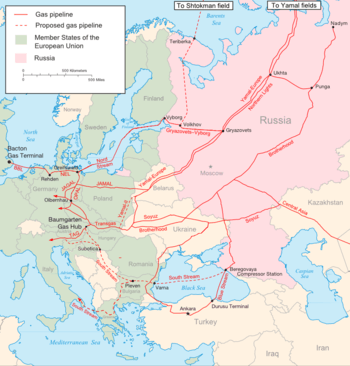Altai gas pipeline
| Altai gas pipeline | |
|---|---|
| Location | |
| Country | Russia, China |
| General direction | north–south |
| From | Purpeyskaya compressor station (Urengoy-Surgut-Chelyabinsk pipeline), Russia |
| Passes through | Alexandrovskoye, Vertikos, Parabel, Chazhemto, Volodino, Boyarka, Novosibirsk, Barnaul, Biysk, the Kanas mountain pass |
| To | Xinjiang region (West–East Gas Pipeline), China |
| Runs alongside | Urengoy–Surgut–Chelyabinsk, Northern Tyumen regions–Surgut–Omsk, Nizhnevartovsk gas refinery–Parabel, Parabel–Kuzbass, Novosibirsk–Kuzbass, Novosibirsk–Barnaul, Barnaul–Biysk pipelines |
| General information | |
| Type | natural gas |
| Partners | Gazprom |
| Operator | TomskTransGaz |
| Technical information | |
| Length | 2,800 km (1,700 mi) |
| Maximum discharge | 30 billion cubic meters per year |
The Altai gas pipeline is a proposed natural gas pipeline to export natural gas from Russia's Western Siberia to North-Western China.
History
The memorandum on deliveries of Russian natural gas to China was signed by Gazprom CEO Alexei Miller and CNPC CEO Chen Geng during Russian president Vladimir Putin's visit to China in March 2006.[1][2] The project was put on hold due to disagreements over natural gas price and competition from other gas sources in the Chinese market.[3][4]
In 2013, Gazprom and CNPC agreed to instead pursue a more eastern route, the Power of Siberia gas pipeline.[5][6] In 2014 the projected was resumed during the APEC summit.[7][8][8]
Route
The 2,800 kilometres (1,700 mi) long pipeline would start from the Purpeyskaya compressor station of the existing Urengoy–Surgut–Chelyabinsk pipeline. It would carry natural gas from Nadym and Urengoy fields in Western Siberia. Total length of Russian section will be 2,666 kilometres (1,657 mi), including 205 kilometres (127 mi) in Yamalo-Nenets autonomous region, 325 kilometres (202 mi) in Khanty–Mansi autonomous region, 879 kilometres (546 mi) in Tomsk Oblast, 244 kilometres (152 mi) in Novosibirsk Oblast, 422 kilometres (262 mi) in Altai Krai, and 591 kilometres (367 mi) in the Altai Republic. The terminal point in the Russian territory is the Kanas mountain pass. Large part of the pipeline will be built within the technical corridor of existing pipelines, such as the Urengoy—Surgut—Chelyabinsk, Northern Tyumen–Surgut—Omsk, Nizhnevartovsk gas refinery – Parabel, Parabel—Kuzbass, Novosibirsk—Kuzbass, Novosibirsk—Barnaul, and Barnaul—Biysk pipelines.[9] In China, the pipeline would be terminated in the Xinjiang region, where it will be linked to the West–East Gas Pipeline.[2][10]
Technical description
The diameter of the pipeline would be 1,420 millimetres (56 in).[11] The designed capacity of the pipeline would be 30 billion cubic meters (bcm) natural gas annually and the total costs of the whole project is expected to be up to US$14 billion. The pipeline was originally expected to become operational in 2011.[1] The pipeline will be built and operated by TomskTransGaz, the subsidiary of Gazprom.[2]
Controversy
The pipeline project was criticized by environmental organizations, because it was planned to run across the Ukok Plateau, which is the natural habitat of the snow leopard and other endangered species. Besides, Altai national leaders fear that laying the pipeline and accompanying technical highway will pave way for a Chinese expansion into Altai.[12] The pipeline route impacts burial sites and shrines in the region. [13]
References
- 1 2 "Natural Gas in Exchange for Time". Kommersant. 2006-09-16. Retrieved 2008-12-21.
- 1 2 3 "Altai Project". Gazprom. Archived from the original on 3 October 2010. Retrieved 2010-10-09.
- ↑ Richard Weitz (2009-06-23). "Global Insights: Chinese-Russian Relations the Best Ever?". World Politics Review. Archived from the original on 29 June 2009. Retrieved 2009-07-15.
- ↑ Kelly Zang (2008-10-08). "Russia to delay construction of proposed gas pipeline to China - Xinhua". Forbes. Retrieved 2009-07-15.
- ↑ "Gazprom, CNPC sign memorandum on eastern route pipeline gas supplies to China (Part 2)". Interfax. March 22, 2013. Retrieved 2014-04-10.
- ↑ Svetlana Kyrzhaly (March 27, 2013). "Gazprom "has forgot" about "Altai", concentrated at the "Power of Siberia" project". Oil and Gas, Metals and Mining News. Retrieved 2014-04-10.
- ↑ http://chinababe.ru/delkit/politics/2014/11/11/apec-results/
- 1 2 http://interfaxenergy.com/gasdaily/article/14214/altai-pipeline-will-go-direct-from-russia-to-china
- ↑ "Export pipeline "Altai" will cross six regions of Siberia: REGNUM publishes summary of the main pipeline characteristics". Regnum. 2007-01-30. Retrieved 2008-12-21.
- ↑ John Helmer (2008-11-11). "China stumbles in forging Russia gas deals". Asia Times. Retrieved 2009-07-15.
- ↑ "Алтайская карта "Газпрома"" (in Russian). Нефть и Капитал. 2007-01-17. Retrieved 2008-12-21.
- ↑ "Altai community approves gas pipeline construction to China following harsh argument". Regnum. 2007-03-22. Retrieved 2008-12-21.
- ↑ Pilgrims and Tourists. Earth Island Institute. 2014. Retrieved 2015-05-15.
